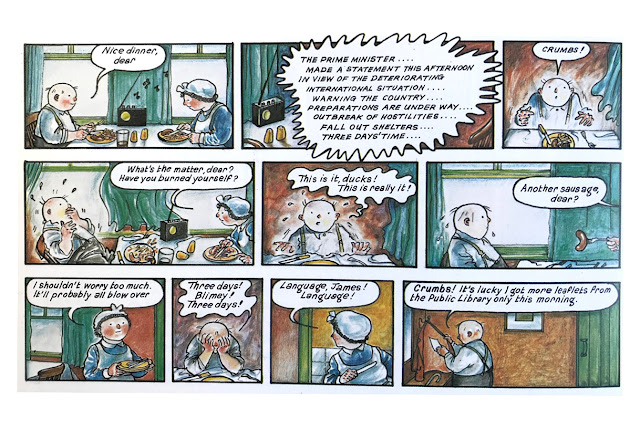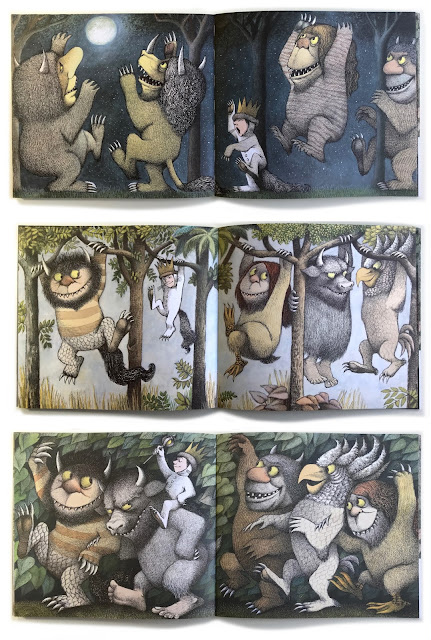In the early 1980s, the world
was gripped by the threat of nuclear war. Soviet leaders were convinced that the US and its allies were a finger touch away from a pre-emptive strike and as
a schoolboy living in Berkshire it felt like we were right in the middle of
it.
I remember seeing foreboding images of giant mushroom clouds on posters and
T shirts and reading books on
building fall-out shelters.
I also remember watching a film, which might have been “The Day After” (whatever it was I wasn’t meant to be watching it), depicting a full-scale nuclear exchange between the United States and the Soviet Union, and it was terrifying! My friends and I would role-play what we would do the day after a nuclear
attack, build shelters in the woods and store supplies of cheese sandwiches and crisps. And with cruise missiles being
delivered to the nearby Greenham Common airbase it only fuelled our imaginations.
To add to the nuclear smorgasbord I read “When the Wind Blows” by Raymond Briggs.
The recent quarrels
between the United States and North Korea brought back my memories of the nuclear '80s and prompted me to re-read Briggs' graphic novel. Isn’t it funny how things come around!
“When the Wind Blows” follows
pensioners James and Hilda Bloggs, as they naively prepare for a nuclear attack under
the guidance of “The Householder’s Guide to Survival” which James has found that morning in the local library. The strike is predicted over the radio to arrive “in three days time”.
The tension and apprehension of
the ensuing attack increases over each page as the couple fumble to construct their makeshift
shelter out of doors and cushions.
Panel by panel the couple are edged closer
and closer to the moment of impact…
Until…
While it’s tempting to write
“BOOM” it is not necessary. The emptiness is all this spread needs and I
found it as astonishing and as powerful as I remember I did on my first
reading as a schoolboy. And it is this spread that has prompted me to write this post.
But what is it that makes this
page turn so arresting? After all, it is
a spread with no words and virtually nothing on it at all - just a pale pink edge
to an empty white .
But that’s just it. The eerie
silence after all the busy chatter is shocking and the simplicity of the white
is exactly how those film clips I saw as a boy described what the nuclear flash would look like when it hit, and within the story the timing is perfect. This empty nothing has so
much impact.
With the visual power of Briggs' wordless double spread in mind I hunted through my picture book collection for
other wordless double spreads to enjoy. Here are a few of my favorites, some
familiar and some less so, some light-hearted, some contemplative and a couple biographical.
The first is the forest made of rubbish from “The Tin Forest” by Helen Ward and illustrated by Wayne Andersen. (Templar 2001) Here are two spreads from the story. The first shows the reality of the old man's garden
...and then its transformation later in the book, into his dream paradise.
The inimitable “Where the Wild Things Are” by Maurice Sendak. (Harper & Row 1963)
Three wordless double spreads in a row of the “wild rumpus”. Not only giving the reader the raucousness of Max and his subjects messing about but also a sense of time passing and that they play until they can’t play anymore.
Another dream image, this one the imagined journey mapped out by a young Christopher Columbus in “Follow the Dream” by Peter Sis. (Knopf 1991)
A cruel blizzard sets in on Elephant island. From “Shackleton’s Journey” by William Grill. (Flying Eye Books 2014)
In the entrance to the upturned barn she has converted into an ark is Norah, calling to the animals as the rain begins to start.
And later them all waking up to see how high the waters had risen during the night.
From
The sudden capture of the spider in Carson Ellis’ “Du Iz Tak?” When you first read this book, this page is startling and takes you and the characters totally by surprise. (Walker 2016)
The terrifying roar of the lion after having “eaten the whole of the London Symphony Orchestra for breakfast, instruments and all.” Kit Williams "Book Without a Name" (referred to by Williams as "the Bee Book" Knopf 1984)
The unnoticed Elliot from “Little Elliot Big City” by Mike Curato. The sudden shock of loneliness
in a crowded city. You just want to jump in there and rescue him. (Henry Holt & Co 2014)
The mystery uncovered as Bear's secret paper making machine is discovered in Oliver Jeffers “The Great Paper Caper” (Harper Collins 2008)
And lastly the double fold out spread from “Grandpa Green” By Lane Smith where “the garden remembers for him.” (Roaring Brook Press 2011)
What all these examples have for me is a
sense of impeccable timing within the narrative. A moment where the story almost stops, where
the reader might take a breath, absorb and be suspended by, or simply fall into
the illustration. Something wonderfully unique to picture books and akin
to a moment in a film where there is silence, where the camera pans back to
allow the viewer space to consider and ponder what's going on, and perhaps a subtle message for anyone whose finger might be hovering over a red button.
I love these wordless spreads,
not just because as an illustrator they give full reign to the image but because they sit so well within the words adding another visual
moment of texture and depth to the story.
If you have any favourites, let me know.
Garry Parsons is an illustrator. You can see his work here and follow @icandrawdinos
***



















9 comments:
A lovely post, Garry. Where the Wild Things Are was a favourite bedtime read for both of my children when they were toddlers. When we got to the 3 textless spreads shown above we used to sing a tune and dance. :)
What a great ode to the power of pictures! I loved discovering some new examples. It's hard to pull off a wordless picture book, but interesting to consider adding visual space and no words to the climactic turning point.
Thank you Natascha. Definitely a tool to consider when pacing a picture book.
Thats great Jonathan, I love that idea.
Great post - I adored reading (and looking!) at this, Garry. You inspired me to flick through some of the books on my shelves. None have the impact of the blank page in 'Where the Wind Blows' - thanks so much for introducing this to me.
I noticed 'Little Rabbit Foo Foo' ends with a wordless double-page image, which I suppose is meant to encourage a discussion about the dramatic outcome of the story. Whilst the end of We're Going on a Bear Hunt always made me sad for the lonely, misunderstood bear, although I'm not sure if the image in my paperback would originally have been an end paper in a hardback edition and perhaps isn't really the final image and instead is more of a quiet reflection.
Other wordless double-page spreads I noticed in the middle of books included 'The Big Big Sea', 'Penguin', 'A Bit Lost', 'A Perfect Day', and 'Don't Let the Pigeon Drive the Bus'. Although there are quite a few wordless books, I'd never consciously thought about the pause of a wordless spread amidst pages of combined images and words, and how effective it can be. Like so many writers I felt the urge to include words, even if it was only one word. Interesting.
What wonderful drama! It's perhaps not surprising that all your examples are, I think, by author/illustrators except for the Cartwrights who were husband and wife working together. Do authors dare shut up and let the pictures talk enough, I wonder? Thank you, Gary.
Thanks Pippa. I think the urge to add words to any page is compulsive so some faith and confidence is needed to leave them out, not only by the author or illustrator but the editor and designer too. I love the Cartwrights book and I can imagine them discussing this in depth.
Thank you for your suggestions of books Paeony, I'll have a look at those. My picture book as author & illustrator "Krong!" ends with a spread with just the word "Wow!" and I've always wondered about the necessity of that. But where I've found the "Wow!" really works is when I'm reading the story aloud to a group of children. My next blog might have to be about spreads using one word!
I arrived here tonight, December 27 2022, having rediscovered my very old and well worn The Picture Book of Dogs. Ward Lock. I gifted it to my Daddy in 1955 when I was 7. My son was gifted When the wind Blows, and Where the Wild Things are. He still has them, as they were passed on to his children. Such precious memories.
Post a Comment